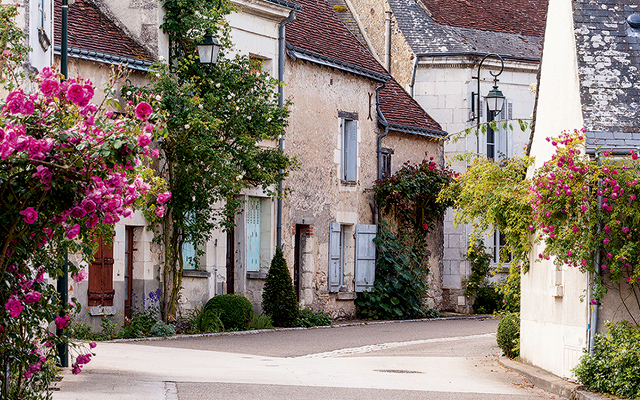The roses of Chédigny
Alison Hughes enjoys a vie en roses at Chédigny in France.


There are more rose trees than inhabitants in the tiny village of Chédigny (more than 700 roses, but 550 people), which sits some 15 miles due south of Amboise, in the verdant region of Indre-et-Loire. Watered by those two rivers, this is a region of beautiful and famous gardens, most of which act as backdrops to the châteaux that they surround. Some of them, like nearby Chenonceau and Villandry, have been awarded the coveted title of jardin remarquable, but Chédigny is the only village in the whole of France to be given such recognition.
It all started with Pierre Louault, Chédigny’s mayor for the past 38 years, and his passion for ancient rose varieties. Inspired by a visit to Grignan, in the Drôme, he planted the first climbing rose in the village in 1998; he then enlisted the help of rose specialist André Eve and, soon, a plan to transform the whole village was born.
A variety of climbers and ramblers such as Madame Isaac Pereire (noted for its scent) and Neige Rose (noted for its abundant blooms and long flowering) were selected for the façades and standard bushes such as the delicately white-petalled Jacqueline du Pré for the more open spaces.
White and purple wisteria joined the rambling roses; catmint, lavender and bay were added for ground cover and marguerites, echinacea and hydrangeas added banks of colour. As the planting continued, the natural solution was to replace all of the pavements with flowerbeds and turn the streets into walkways. This was part of M. Louault’s vision to ‘give the village back to the people’, returning it to being a place where people could stroll and chat with their neighbours. With the help of grants from various councils, electric cables and telephone wires were buried, drainage was overhauled and lamp posts more in keeping with the aesthetics of the village were erected.
People began to take more interest in their own gardens, not just the streets; the primary school became involved—last year’s project was to create a haven for insects in one of the flowerbeds. Take a walk down the main street and you’re bound to see an octogenarian or two busily pruning or deadheading. In short, the project has overtaken everyone.
Marie-Paule Guilbaud, a journalist who turned her hobby into a new career, is now the village’s head gardener. With two apprentices and one part-timer, she’s responsible for new planting and maintenance in the streets. ‘I love the energy here; the sense of evolution, of new projects and the general dynamic of the place,’ she says. The first fête des roses, held in May 2006, attracted 3,000 visitors; last year, 15,000 came over the two days.
The rebirth of the village has played no small part in drawing people back, such as Monique Boitard, president of the Association of the Roses of Chédigny, who lived for 30 years in the north before returning to her roots. Newcomers such as Michel Foriez, the bookseller, and Stéphane Tortissier, who runs Le Clos aux Roses, a restaurant and B&B, have been drawn to the newfound beauty of Chédigny.
Exquisite houses, the beauty of Nature, and how to get the most from your life, straight to your inbox.
This year’s festival is now over, but it’s still possible to sign up for one of the regular guided walks or, of course, just stroll around by yourself. Notice the planting of low shrubs near the church: it’s a very unusual sight in France, where churches are usually surrounded by stone and concrete.
Along the main street, purple shutters and railings match the nearby lavender bushes and, further down, a Bordeaux-red door echoes the rambling rose overhead a touch of humour indicative of the spirit of the Chédignois. As one resident pointed out: ‘If by coming together as a village and respecting what Nature has to offer, we can show that, therein, lie the seeds of happiness, then who is to say that we’re not part of the butterfly effect that helps to change the world?’
www.chedigny.fr; www.rosesdechedigny.canalblog.com
Country Life is unlike any other magazine: the only glossy weekly on the newsstand and the only magazine that has been guest-edited by His Majesty The King not once, but twice. It is a celebration of modern rural life and all its diverse joys and pleasures — that was first published in Queen Victoria's Diamond Jubilee year. Our eclectic mixture of witty and informative content — from the most up-to-date property news and commentary and a coveted glimpse inside some of the UK's best houses and gardens, to gardening, the arts and interior design, written by experts in their field — still cannot be found in print or online, anywhere else.
